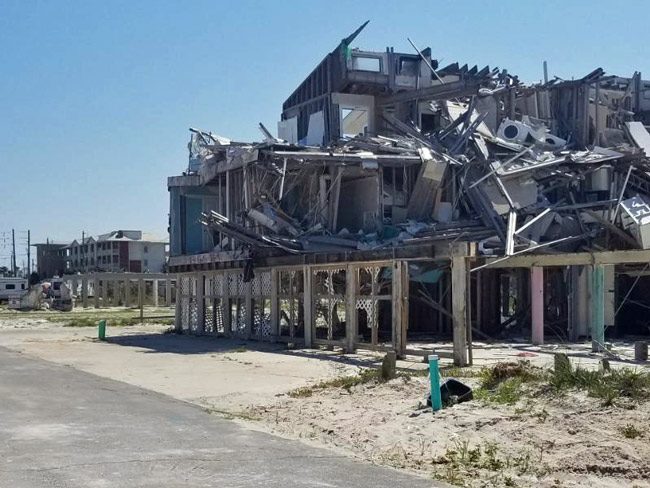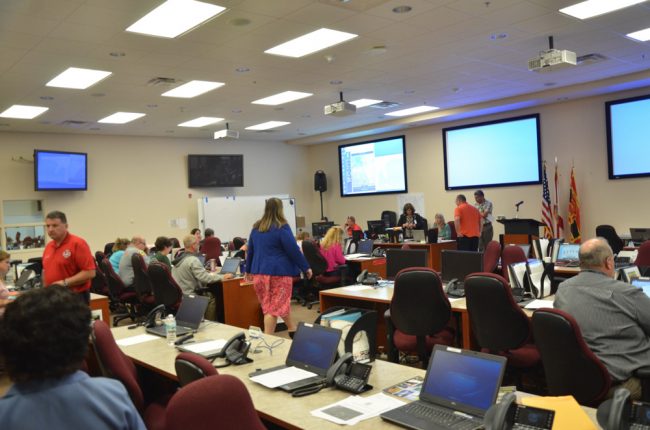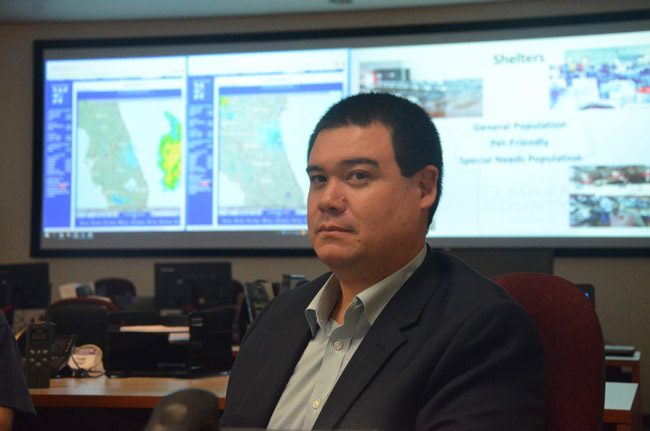
When it comes to hurricanes, the gods like to terrorize Florida in streaks: seven hurricanes struck the state between 1944 and 1950, then nothing for 10 years. Three hurricanes between 1960 and 1975, then 17 years’ calm but for Eloise in 1975, before the catastrophe of Andrew in 1992, the Category 5 hurricane that demolished Homestead. A few more years’ quiet, then five hurricanes in two years between 2004 and 2005–Charley, Ivan, Jeanne, Dennis and Wilma.
Then 11 more years of nothing until the deities seemed to take a shine for Flagler, long neglected by their wuthering malice: Matthew and Irma struck in successive years, Matthew not directly and Irma more as a tropical storm by the time it whipped about locally, but enough to devour miles of dunes, flood swaths of the barrier island, require tax increases and the diversion of millions of dollars toward repairs, some of it reimbursed, much of it not. (Hermine also struck the Panhandle in 2016.)
Flagler fared better last year. The Panhandle did not, as Michael, the first Cat 5 to hit abuse Florida since Andrew, made landfall. The hurricane’s cruelty GPS must have malfunctioned: its envelope was relatively sparsely populated, though that was meaningless to residents from Panama City Beach to Mexico Beach, and to a state that still sustained $25 billion in damages.
A faded banner, draped across the second-story balcony of a weather-battered shell of a home, sends a message: “Mexico Beach will rise again.”
Nearby, several residents, rather than having real-estate signs planted in the sandy remains of their properties, defiantly declare the sites are not for sale, more than seven months after Hurricane Michael — packing 160 mph sustained winds — laid waste to the beach town and surrounding region.
“We love our neighbors and our community,” says a sign outside an empty, stilted beachfront residential property.

With the new hurricane season approaching, Mexico Beach resident David Kiser simply shrugged when asked about the approach of another storm season.
“I always pay attention to hurricane season,” said Kiser, a longtime Panhandle resident who has lived in Mexico Beach for 16 years. “I’m not going anywhere, but I’m not riding them out.”
In Florida, “The Gods Must be Crazy” isn’t a movie, and it’s never funny. It’s hurricane season. And it’s back. It started, in the absurdist theater of climatological quirks, at a minute after midnight Saturday, ending on the last stroke of Oct. 31.
“For us it means absolutely nothing,” says Jonathan Lord, who heads Flagler County Emergency Management. “Let me qualify that statement: whether or not they say it’s going to be the busiest season in the world or the quietest in history, in my mind that means absolutely nothing, because if that one storm heads for Flagler County, it makes the rest meaningless.” Hurricane Andrew, Lord notes, struck during what was supposed to be a “quiet” hurricane season. It killed 65 people and caused $47 billion in damage in today’s dollars.
Colorado State University hurricane researchers, who annually predict what sort of hurricane mood the gods are in, in April predicted 13 named storms, five becoming hurricanes and two reaching major hurricane strength–Cat 3 or higher–with sustained winds of 111 miles per hour or greater. The team is issuing an updated forecast next week.
Lord seems to prefer the more range-oriented forecast of the National Hurricane Center. As of May 23, the Miami-based center was forecasting nine to 15 storms, four to eight of them becoming hurricanes, two to four becoming major hurricanes. The forecasters don’t plot paths for the storms, which originate in dust devils over west African sands before using the energy of the Atlantic to rev up in violence. What Lord wants Flagler residents to know is that despite the eventually weakened states of Matthew and Irma, by the time they sheared over the county, “we are not immune to a Category 5 hurricane.”
In preparation for the hurricane season, Lord has reconfigured the Emergency Operations Center’s structure when it is in emergency mode, increasing the number of “partners” seated in the center, when all local governments, law enforcement, Florida Power and Light, the National Guard and several non-profits coordinate and operate out of the bunker-like, hurricane-proof facility in Bunnell. There’ll be more space for state law enforcement, a state emergency liaison and volunteer groups, who play a key role in storm response.
In the past year the EOC has adopted Web EOC, a relatively new standard of emergency operations “connectivity” intended to close communication gaps between local, state and federal agencies as an area struck by an emergency seeks to line up resources. The system allows Flagler to track its resources better and make requests more efficiently. It also helps when tabulating paperwork for eventual reimbursements from the Federal Emergency Management Administration, the perennial migraine of post-event recovery.
Lord also coordinated a week-long drone-flying class, taught by Florida State University experts, for about a dozen local emergency responders from Flagler County Fire Rescue, the Palm Coast and Flagler Beach fire departments and the Flagler County Sheriff’s Office. “It’s very much the future of public safety,” Lord said of drones. He recognizes the civil liberty issues at the intersection of drones and law enforcement. But for other responders, drone-flying “allows us to do a lot more good in a much more cost-effective manner.”
“If we had an area that was inaccessible otherwise, then yes, I would ask the team that was trained to go out and do assessments, and that could be done in partnership with Fire Flight, in lieu of Fire Flight if Fire Flight wasn’t available,” Lord said of using drones. Fire Flight is the county’s emergency helicopter.

(© FlaglerLive)
Internally, Lord over the past year met with every single county employee, with every employee going through EOC to understanding its workings. The reason: county employees are expected to change gear during emergencies and fulfill whatever roles they’re assigned–and not necessarily stay home with their families. They become part of the emergency response. But they have to be prepared, both in terms of knowing what will be expected of them and knowing how and where they will shelter their families, so they’re not anxious about leaving them for work.
Through grants, emergency management also oversaw $650,000 in “hardening” work on fire stations, community centers and shelters, with $1.6 million more lined up in the future to do likewise at the hospital, the county jail and other facilities.
You’d think emergency management were a big department. It’s not. It consists of five people, Lord included, operating on a $642,000 annual budget. But its role is disproportionate to its size when emergencies strike as it turns into the hub of activity and coordination, with the management chief ostensibly wielding more authority than most local officials.
Lord has been preaching his emergency-preparedness gospel to local media and government ahead of the hurricane season, as he usually does, capping his recommendations with words to residents: be prepared, keep your hurricane kit in good order even after the season elapses (it’s not just for hurricane emergencies), know your evacuation plans ahead of time, never stay in place when your area has been ordered evacuated, and don’t think of shelters as more than that: a roof and four walls, not a hotel.
But the psychology of evacuation is of concern to state officials. Mark Wool, a meteorologist with the National Weather Service in Tallahassee, said the state’s recent hurricane experiences have led to talk about tempering the tone of storm updates.
“The entire population of Florida has a heightened sensitivity to perceived threats,” Wool said. “In fact, this year there may be a little bit of skittishness.” While nothing has come of the talk, Wool noted that the rash of destructive hurricanes during the past three years should translate into more people taking to the roads in search of shelter.
“No one is going to attempt to go through Michael a second time,” he said. “We’re involving social scientists more and more these days, to try and figure out what compels somebody to evacuate versus deciding to stay,” he added. “Prior experience is the chief motivator. People who think they have experienced something bad in the past will go ahead and evacuate. Those who don’t have that experience may not.”
For the fifth consecutive year, the Atlantic has started acting up before the calendar turned to the page marking the start of the hurricane season.
Andrea was a short-lived tropical system that organized hundreds of miles southwest of Bermuda on May 20. Next on the list are Barry, Chantal, Dorian, Erin, Fernand, Gabrielle and Humberto.
–The News Service of Florida contributed to this report.
![]()




























Stormy Weather says
Doomed I say. We are ALL doomed . Leave now and have plenty of time to get back to New York . Hurry, take the kids and grandkids. Don’t forget your pets. Hurry before the ” BIG ONE” hits us. Doomed, we are ALL doomed !
Dave says
Good bye A1A! Hello Central ave as the new throughway. We need to remove all trailer homes from withing 3 miles of the ocean. They have no right to be so close to a possible disaster causing our rescue teams to have to save them when they should be living in Bunnell If they prefer a trailor.
Nancy says
Great article. We stayed for Michael and your right about skittish. So many are still living with damaged roofs and homes, us being one. Major causes: fighting insurance companies, waiting list for reputable companies, loss of local labor pool due to housing/apartment building losses, shoddy work that needs to be fixed, and the saddest is those that took the money only to dissapear. In a pre-Michael state, one could afford to be very picky with who to hire, but when you call 6 people and you’re lucky to get 1 to show up, desperation starts to set in.
Out of 27,000 students, nearly 3,700 students left the system, mostly because families moved away to find housing. More than 4,800 students still attending school were considered homeless as of May, and the school system lost over 200 employees. Above from https://spotlightonpoverty.org/spotlight-exclusives/florida-schools-still-begging-for-help-after-hurricane-michael/
Didn’t Hurricane Sandy put a hurting on NY?